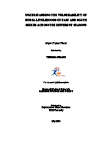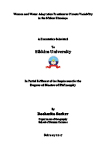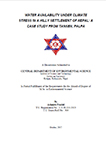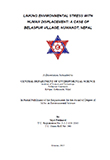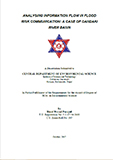Understanding the Vulnerability of Rural Livelihoods of East and South Sikkim Across the Different Seasons
Vishaka Gulati, Students' Dissertation, 2015
Mountain ecosystems are amongst the most fragile environments on the earth and are “characterised by a high degree of poverty, fragility, marginalization and low accessibility” (Macchi et al., 2009). They are a rich source of biodiversity and also providers of many ecosystems goods and services. Major rivers in the world originate from the mountains and play a very important role in providing water to the communities living downstream. People living in the mountains are highly dependent on natural resources for their basic needs as well as livelihood and are comparatively more exposed to extreme events thereby making them even more vulnerable to the changing climate.
Understanding Differential Vulnerability to Climate Change: A Case Study Approach
Ganesh Gorti, Students' Dissertation, 2015
The global trends of Carbon-di-oxide have seen a rise ever since the industrial revolution, so have the ill-effects arising out of such a rise. Surveys around the world have indicated that, like (Cook, 2015), an overwhelming majority of the scientific community now believes that climate change is for real and that its impacts are already being felt.
Hydropower and Climate Variability: Issues of Adaptation in Upper Tista Catchment
Navin Rai, Students' Dissertation, 2017
In the face of climatic variability, the Kyoto protocol (1998) declared profoundly that GHGs are major sources of global warming and environmental degradation and there should be an alternative for fossil fuel based energy. Since, then the hydropower is globally considered as win-win and green energy to tackle increasing GHGs emission from fossil fuel based energy.
Women and Water: Adaptation Practices to Climate Variability in the Sikkim Himalaya
Rashmita Sarkar, Students' Dissertation, 2017
The purpose of this study is to document the dynamics of adaptation practices related to sustainable usage of water engaged by women in their everyday life in a mountain socio-ecological system. Such system represents the ensemble of resource-use practices, natural settings, institutional practices, and social landscape.
Water Availability Under Climate Stress in a Hilly Settlement of Nepal: A Case Study form Tansen, Palpa
Ashmita Paudel, Students' Dissertation, 2017
Only two-and-a-half percent of the water available on earth is freshwater. Thirty percent of the total volume of freshwater on earth is groundwater. Groundwater sources are massive but finite. Many human settlements around the globe are dependent on groundwater.
Understanding Climate Change and Role of Community Forestry Governance in Climate Change Adaptation: Cases from Udipur, Lamjung
Regan Sapkota, Students' Dissertation, 2017
Local communities are considered more vulnerable to climate change due to their low adaptive capacity. In Nepal, many adaptation practices have been carried out to reduce its impacts by different institutions, Community forestry (CF) is one of them. CF in Nepal is considered as one of the successful institutions of Nepal and good governance of it is considered as the pillar of its success.
Linking Environmental Stress with Human Displacement: A Case of Belaspur Village, Nuwakot, Nepal
Sijal Pokharel, Students' Dissertation, 2017
Environmental change is shaping human migration now and will do so in future; specifically through its influence on a range of economic, social and political drivers. Development of the vision for how human population movements across the world could be affected by global environmental changes with a focus on the diverse challenges and opportunities for populations in originating and receiving regions is as inevitable as environmental change.
Analysing Information Flow in Flood Risk Communication: A Case of Gandaki River Basin
Binod Prasad Parajuli, Students' Dissertation, 2017
Flood is a major disaster causing devastation every year in major river basins of Nepal and India. The risk associated with the floods can be reduced to greater extent with proper information flow regarding flood risk management.
Literature Review of Critical Climate-Stress Moments in the Hindu Kush Himalaya: A Resource Kit
Resource Kit, 2018
This resource kit presents a compilation of information on critical climate-stress moments in the Hindu Kush Himalaya (HKH) region. The information is based on a literature review on critical-climate stress moments in agriculture and health due to heat stress and discusses critical moments emerging from downstream and upstream floods.
Developing the Criteria for Classifying and Assessing Climate Change Adaptation Options in the Gandaki River-basin
Workshop Proceedings, 2016
The workshop on ‘Developing criteria for classifying and assessing climate change adaptation options in the Gandaki river-basin’ was commissioned to engage relevant stakeholders in the design of a Climate Change Adaptation Matrix, get their inputs to improve the classification of adaptation options, and identify the most important criteria for policy makers and practitioners to evaluate or assess adaptation options. Participants from more than 20 different organizations in Nepal working on climate change adaptation in various sectors and at different levels were present at the workshop.

